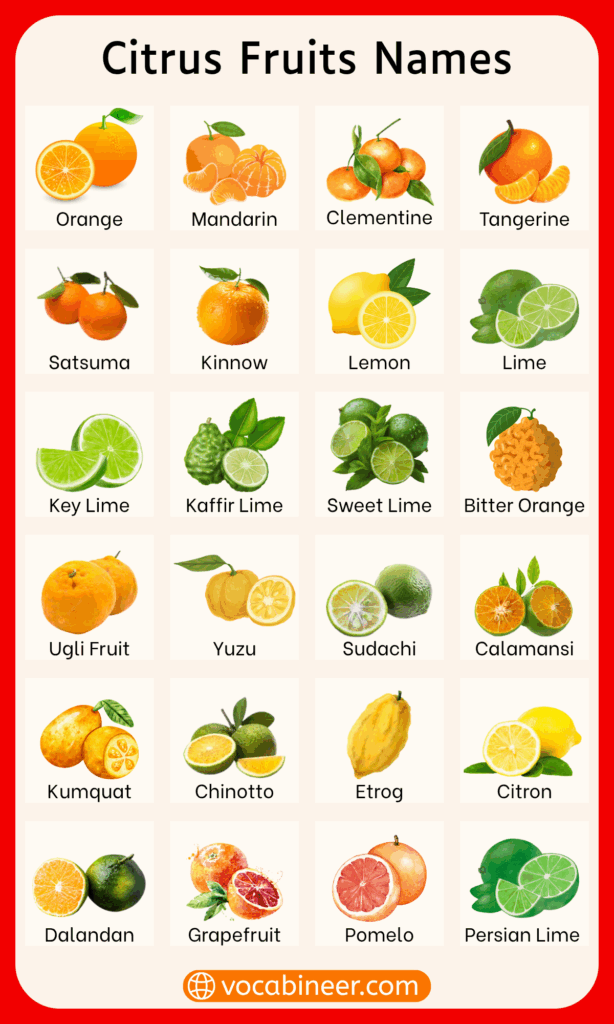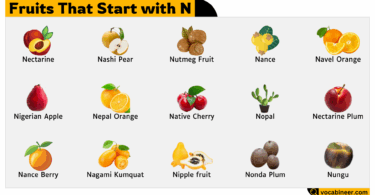Citrus fruits include many types that differ in flavor, size, and color. Known for their juicy pulp, refreshing taste, and distinct aroma, these fruits are enjoyed worldwide. From common favorites like orange and lemon to exotic varieties such as yuzu and kumquat, citrus fruits bring bright flavor and nutrition to meals and drinks. Below is a list of 30 citrus fruits names in English with pictures to help you identify and learn them easily.
In This Page
Complete List of Citrus Fruits Names in English
This list shows many types of citrus fruits, from common ones like oranges and lemons to rare ones like yuzu and kumquat.
- Orange
- Lemon
- Lime
- Grapefruit
- Tangerine
- Mandarin
- Clementine
- Satsuma
- Pomelo
- Kumquat
- Yuzu
- Calamansi
- Bergamot
- Key Lime
- Blood Orange
- Sweet Lime
- Finger Lime
- Ichang Papeda
- Kaffir Lime
- Sudachi
- Ugli Fruit
- Tangelo
- Citron

Names of Citrus Fruits with their Images
Citrus fruits come in many types, each with its own unique look and taste. Here are some common and exotic citrus fruits you should know.
Common Citrus Fruits Names
- Orange
Bright orange skin with juicy, sweet segments inside. - Lemon
Yellow and oval, lemons have a tart flavor and thick peel. - Lime
Small and green, limes are sour and often used in drinks. - Grapefruit
Larger than oranges, grapefruits have a slightly bitter taste. - Tangerine
Small and easy to peel, tangerines are sweet and juicy.
Exotic Citrus Fruits Names
- Pomelo
The largest citrus fruit, with thick skin and mild sweet pulp. - Kumquat
Tiny fruit with edible sweet skin and tart inside. - Yuzu
A bumpy yellow fruit mostly used for flavoring in cooking. - Calamansi
Small and sour, popular in Southeast Asian cooking.
How to Identify Citrus Fruits
Most citrus fruits share common traits like segmented juicy pulp and thick, leathery skin. To tell them apart:
- Check the color: oranges are bright orange, lemons are yellow, and limes are green.
- Look at size: pomelos are large, kumquats are tiny.
- Feel the peel: tangerines have thin, easy-to-peel skin; lemons and grapefruits have thicker, tougher skins.
Uses and Nutritional Benefits of Citrus Fruits
Below is a list of popular and exotic citrus fruits, highlighting their common uses and nutritional perks. Discover how these juicy fruits can brighten your meals and support your well-being.
- Orange: Eaten fresh or juiced for drinks and desserts. High in vitamin C, fiber, and antioxidants that support immunity and digestion.
- Lemon: Used for juice in cooking, drinks, and zest for flavor. Rich in vitamin C, helps digestion, and has antibacterial effects.
- Lime: Added to cocktails and dishes, with zest used in baking. Good source of vitamin C and antioxidants for skin health.
- Grapefruit: Eaten fresh or juiced, used in salads and desserts. Contains vitamin C and fiber, may support weight loss and heart health.
- Tangerine: Eaten fresh or in salads and juices. Rich in vitamin C and antioxidants to boost immunity.
- Pomelo: Eaten fresh or in marmalades and desserts. High in vitamin C, fiber, and antioxidants for heart health.
- Kumquat: Eaten whole with skin, used in jams and sauces. Rich in fiber, vitamin C, and antioxidants.
- Yuzu: Used mainly for juice and zest in cooking. Contains vitamin C and antioxidants to support immunity.
- Calamansi: Juice used in drinks and marinades. High in vitamin C and antioxidants, helps digestion.
Citrus Fruit Varieties and Characteristics
Each citrus fruit has varieties that differ slightly in taste and appearance:
- Oranges: Navel (seedless), Blood (red flesh), Valencia (juicy for juice).
- Lemons: Eureka (common supermarket lemon), Meyer (sweeter, thinner skin).
- Limes: Persian (larger, less sour), Key lime (small, very tart).
FAQs About Citrus Fruits Names
Tangerines are smaller, sweeter, and easier to peel than oranges.
Yes, kumquats have an edible sweet peel that balances their tart inside.
Not all. Some like sweet oranges and tangerines are mostly sweet, while lemons and limes are sour.
The pomelo is the largest citrus fruit, sometimes bigger than a grapefruit.
Yuzu is mostly used for its juice and zest in cooking and sauces.
Read More




